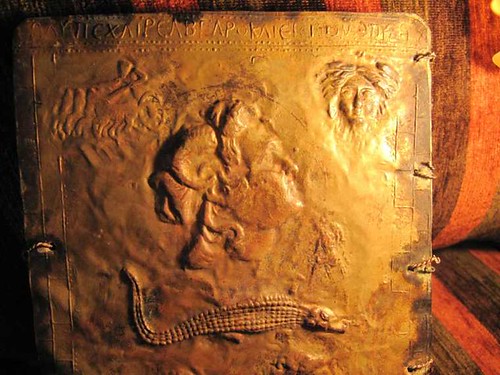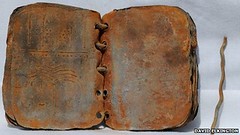
PREV ARTICLE
NEXT ARTICLE
FULL ISSUE
PREV FULL ISSUE
DO THESE LEAD CODICES HAVE A NUMISMATIC CONNECTION?
Arthur Shippee forwarded this link to a blog post concerning some ancient books purportedly discovered recently in the Middle East. He writes: " there may be some "coin connections" with the (probably faked) lead codices' iconography ." I'm not sure I completely get the connection, but here's a paragraph from the blog itself, an earlier referenced blog, and part of an earlier article with images of the items in question. Is anyone familiar with the controversy over these?
-Editor
I do want to highlight a comment by Stephen B-C. in our previous post on this. He astutely notes the resemblance between coin portraits of Alexander the Great and some of the images attached to Peter Thonemann’s letter at Dan McClellan’s blog. I think Stephen B-C is bang on in his commentary. To supplement his analysis, I might note that the (date?) palms which seem omnipresent on all the images that are so far available (some in the new coverage which we will be getting to) are also very reminiscent of palm depictions on coins from Israel in the general period (I don’t think there is an Alexander coin which also has a palm tree, by the way, but I might be mistaken about that). I’m willing to bet that as more images emerge, more ‘coin connections’ will be able to be made. To read the original blog post, see: Lead Codices – Once More into the ‘Reach’ (rogueclassicism.com/2011/04/03/lead-codices-once-more-into-the-reach/)
Here's an excerpt from the cited blog post, which discusses a related bronze tablet.
-Editor

The Greek text at the top of your photo no. 0556 reads: ΛΛΥΠΕΧΛΙΡΕΛΒΓΛΡΟΚΛΙΕΙΣΙΩΝ, followed by ΛΛΥΠΕ in mirror-writing. This text corresponds to ΛΛΥΠΕ ΧΛΙΡΕ ΛΒΓΛΡ Ο ΚΛΙ ΕΙΣΙΩΝ, i.e. ἄλυπε χαῖρε, Ἀβγαρ ὁ καὶ Εἰσίων, followed by the word ἄλυπε again, in mirror writing. The text at the bottom of your photo no. 0532 is the first part of the same text again: ΛΥΠΕΧΛΙΡΕΛΒΓ, i.e. [ἄ]λυπε χαῖρε, Ἀβγ… The text was incised by someone who did not know the Greek language, since he does not distinguish between the letters lambda and alpha: both are simply represented, in each of the texts, by the shape Λ. The text literally means ‘without grief, farewell! Abgar also known as Eision’. This text, in isolation, is meaningless. However, this text corresponds precisely to line 2 of the Greek text of a bilingual Aramaic/Greek inscription published by J.T. Milik, Syria 35 (1958) 243-6 no.6 (SEG 20, 494), and republished in P.-L. Gatier, Inscriptions grecques et latines de Syrie XXI: Inscriptions de la Jordanie, 2: Region centrale (Paris 1986), no.118. That inscription reads, in its entirety, as follows, 1 Σελαμαν χρηστὲ καὶ 2 ἄλυπε χαῖρε, Ἀβγαρ ὁ καὶ Εἰσίων 3 Μονοαθου υἱὸς υἱῷ τειμίῳ τὸ μνῆμα 4 ἐποίησεν ἔτους τρίτου ἐπαρχείας ’For Selaman, excellent and harmless man, farewell! Abgar, also known as Eision, son of Monoathos, constructed this tomb for his excellent son (i.e. Selaman), in the third year of the province’. This is a stone tombstone from Madaba in Jordan, precisely dated to AD 108/9, on display in the Archaeological Museum in Amman. The text on your bronze tablet, therefore, makes no sense in its own right, but has been extracted unintelligently from another longer text (as if it were inscribed with the words: ‘t to be that is the question wheth’). The longer text from which it derives is a perfectly ordinary tombstone from Madaba in Jordan which happens to have been on display in the Amman museum for the past fifty years or so. The text on your bronze tablet is repeated, in part, in three different places, meaningless in each case. The only possible explanation is that the text on the bronze tablet was copied directly from the inscription in the museum at Amman by someone who did not understand the meaning of the text of the inscription, but was simply looking for a plausible-looking sequence of Greek letters to copy. He copied that sequence three times, in each case mixing up the letters alpha and lambda. This particular bronze tablet is, therefore, a modern forgery, produced in Jordan within the last fifty years. I would stake my career on it. To read the original blog post, see: Peter Thonemann on the Lead Codices (danielomcclellan.wordpress.com/2011/03/31/peter-thonemann-on-the-lead-codices/)
Here's an earlier BBC News article.
-Editor
A group of 70 or so "books", each with between five and 15 lead leaves bound by lead rings, was apparently discovered in a remote arid valley in northern Jordan somewhere between 2005 and 2007. The Israeli Bedouin who currently holds the books has denied smuggling them out of Jordan, and claims they have been in his family for 100 years. Jordan says it will "exert all efforts at every level" to get the relics repatriated. The books, or "codices", were apparently cast in lead, before being bound by lead rings. Their leaves - which are mostly about the size of a credit card - contain text in Ancient Hebrew, most of which is in code. If the relics are of early Christian origin rather than Jewish, then they are of huge significance. One of the few people to see the collection is David Elkington, a scholar of ancient religious archaeology who is heading a British team trying to get the lead books safely into a Jordanian museum. He says they could be "the major discovery of Christian history", adding: "It's a breathtaking thought that we have held these objects that might have been held by the early saints of the Church." He believes the most telling evidence for an early Christian origin lies in the images decorating the covers of the books and some of the pages of those which have so far been opened.

Mr Elkington says the relics feature signs that early Christians would have interpreted as indicating Jesus, shown side-by-side with others they would have regarded as representing the presence of God. "It's talking about the coming of the messiah," he says.
I asked Arthur for some more background - his response is below. Thanks!
-Editor
Arthur Shippee writes: Several news sources have been reporting a new "find" and making strong claims for its potential significance. David Meadows' blog posts give links to the media coverage, and to many scholarly opinions that are appearing on academic blogs. The finds are small lead plates, bound together as a codex (i.e., book), inscribed with various symbols and letters, part in Greek and part in the Hebrew script of the time. The codex form was used by early Christians, instead of the roll, and such a thing is mentioned in the Book of Revelation. The suggested claim is that these codices are perhaps mid-first century Christian texts, providing the earliest evidence for Christian beliefs and practices. At present, suspicion is aimed at various points. There are two separate people somehow involved with the "discovery," an Englishman and an Israeli Bedouin. Neither is a scholar, both have, let's say, interesting backgrounds. Their stories, as described by Meadows, are conflicting; also, new "evidence" coming out seems tailored to meet emerging scholarly challenges. Furthermore, the iconography seems to borrow from known coins (hence my alerting Wayne), and the Greek text of one sheet is a mangled form of a known inscription (v.i.). Given the market for Hebrew and early Jewish antiquities, there is a great increase in the number and sophistication of forgeries, and also in the hype surrounding relatively minor finds (e.g., the so-called Gospel of Judas). The way this is being "reported" and handled suggests to some that this is another case of either a forgery or something that will prove trivial or irrelevant. The story is mainly interesting as an example of people trying to manipulate scholarship for non-scholarly gain. Whether there's anything more here, we'll see, but no one who has worked with the Qumran finds or Nag Hammadi finds (both surprises and real) or with the many phony or over-hyped finds is expecting much from this
To read the original article, see:
Jordan battles to regain 'priceless' Christian relics
(www.bbc.co.uk/news/world-middle-east-12888421)
The Numismatic Bibliomania Society is a non-profit organization promoting numismatic literature. See our web site at coinbooks.org. To submit items for publication in The E-Sylum, write to the Editor at this address: whomren@gmail.com To subscribe go to: https://my.binhost.com/lists/listinfo/esylum All Rights Reserved. NBS Home Page Contact the NBS webmaster 
|
